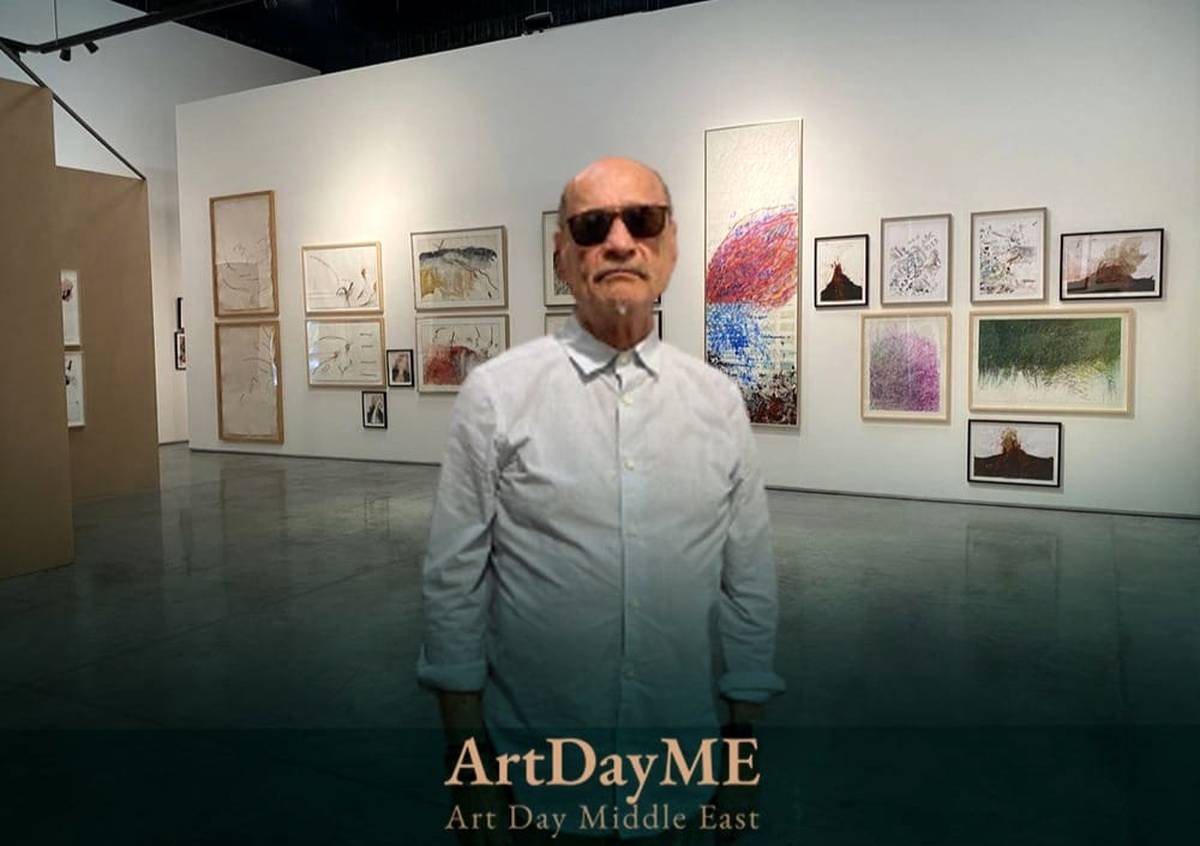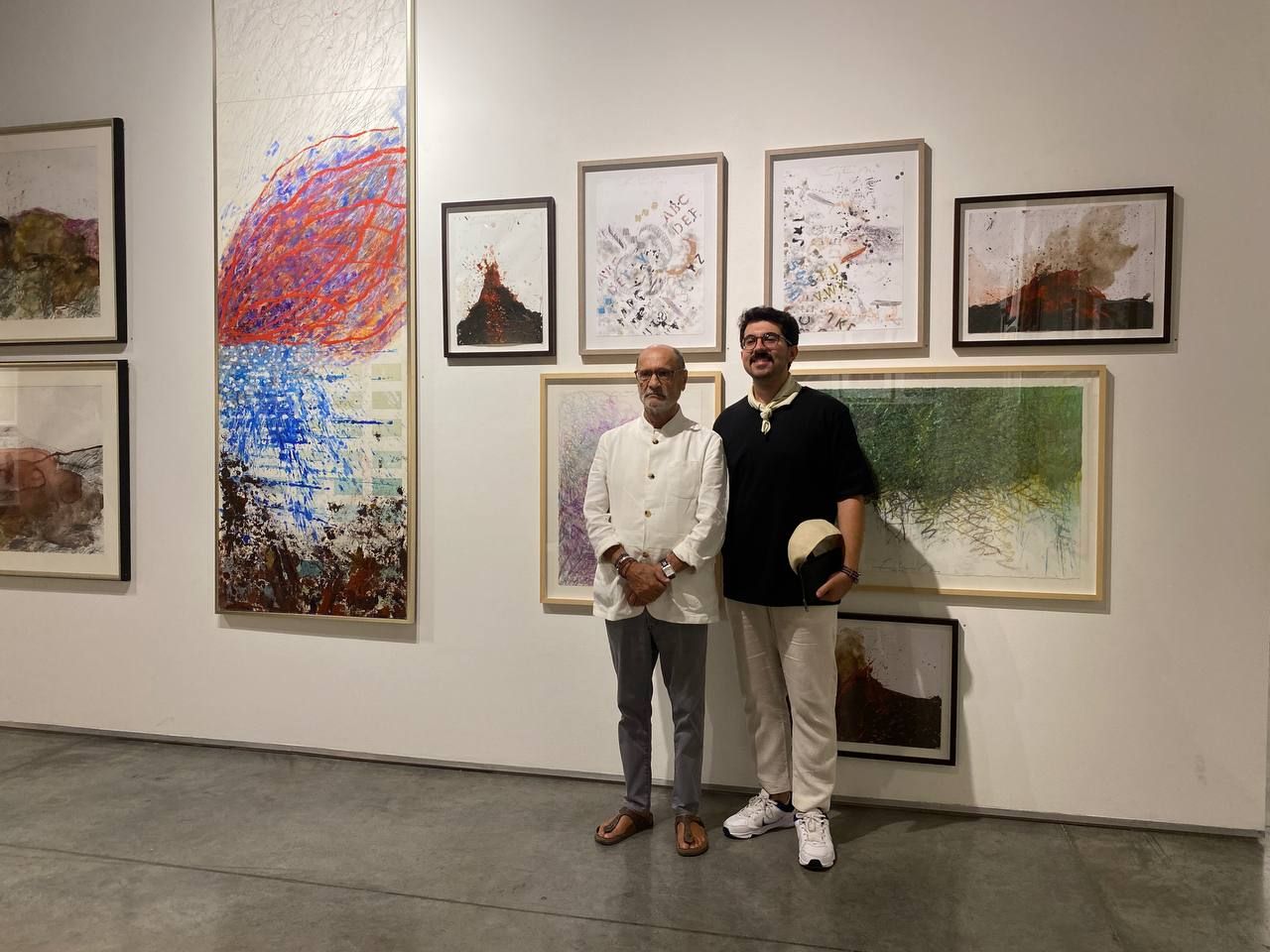
Dubai Gets a Taste of Fereydoun Ave | Two Events at Same Time for a Global Citizen
Because of the particular conditions in Iran, Fereydoun Ave was more than just an artist; he also acted as a bridge that opened up new avenues to prior generations of Iranian art.
ArtDayME: Fereydoun Ave is well-known for his paintings, sculptures, and collages, but he is more than just an artist. He became a bridge that has provided new avenues for contemporary Iranian artistic generations due to the unique circumstances of Iran.
He has actually been showcasing examples of modern Iranian art to the globe for nearly three decades, ever since the 1990s, when no one was aware of it. When you consider that Iran did not have extensive internet access until the 2000s, you'll understand the importance of his outstanding effort..
Ave has produced some excellent works of art, but he has also advanced the discipline as an art director. In a broader sense, he has actually given the world a new, growing perception of the Middle East by redefining Iranian modern art. He holds a prestigious place in Middle Eastern and worldwide art as a result of his vast activities and his important role for discovering modern artists.
Due to this, these days two exhibitions of Fereydoun Ave have been held in Dubai, each of which brings together a part of his magnificent works in two distinct places.
The works of 36 Iranian artists and one Greek artist in the exhibition "Fereydoun Ave and the Laal Collection" started from September 28, 2023 and will continue until March 23, 2024 at the Jameel Arts Centre.
Also, From September 30 to the end of October 2023, the "Retrospective Part I" exhibition by the Tehran-based Dastan Gallery will be on display at the Gallery Isabelle van den Eynde (IVDE) in Dubai.
Ave was born in Tehran in 1945. He, who originates from Yazd in central Iran, was raised in a Zoroastrian family. After losing his father when he was just a year old, he grew up by his dentist mother.
He was sent to an English boarding school at the age of eight. Ave continued there until he was 18 years old, at which point he moved over to Arizona State University in the US and graduated with a BA in theatre and visual arts.
He relocated to New York in 1969 to study film at the New York University, where he took classes with American director Martin Scorsese. Ave argues that staying in New York and absorbing the culture of the time was his greatest instructor. There, he got to know American artist Andy Warhol and a tonne of other famous individuals.
He went back to Tehran in 1970, where new work was being created thanks to the presence of other European-educated artists. Tehran's City Theatre was being built in 1971. In order to support it in terms of ideas and efficiency, Theatre Workshop was established earlier.
Ave initially worked as a designer for the Theatre Workshop before transitioning to the City Theatre. He immediately found employment because of his talent in all areas of theatre poster, stage, costume, and lighting design.
Arbi Hovhannisean's production of "The Cherry Orchard," a widely recognized Anton Chekhov play, served as the subject of the first Drama Workshop presentation at City Theatre. Its costumes were designed by Ave.
Ave also started another area of art management at the time, which he still specializes in today: arranging art exhibitions. First, in Tehran's Iran-America Society Cultural Centre, he organized a number of exhibits for various artists, including Monir Farmanfarmaian and dozens of other renowned artists. Ironically, at the Jameel Arts Centre exhibition the following week, several of those artists' works would once more be on display under his name.
Ave increased his artistic endeavors shortly after by taking over the direction of Tehran's Zand Gallery. In January 1976, he started a career as a painter. He exhibited his debut show that year under the title "Light Design" in Goli Moghtader's Litho Gallery.
Soon after, "Seven Angels," Ave's second event, took place at the Iran-America Society Cultural Centre in Tehran.
Ave's artistic attitude emerged as another name was frequently referenced next to him: the acclaimed American artist Cy Twombly, whose distinctive works of art have earned him awards like the Praemium Imperiale and the Legion of Honor.
In his own words, Ave calls his connection with Twombly "an inspiring 40-year relationship." It's interesting to note that the "Fereydoun Ave and the Laal Collection" exhibition also showcases a Twombly piece that is kept in the Ave Collection.
The visual arts in Iran fell into a coma amid the Islamic revolution, and the Iran-Iraq War further constrained it. Visual artists were unable to display their works in that situation due to a lack of venues.
Ave began working with artists like Parvaneh Etemadi, Abbas Kiarostami , Hooman Mortazavi, Shideh Tami , Shahla Hosseini, and Shahrokh Ghiasi during this period of downturn. The development of collaborative collage-like pieces with Etemadi was one of its shining moments.
Ave established 13 Vanak Street in the early 1990s, which was a groundbreaking and significant concept in Iran's visual arts history. At first, it was only a storefront on Tehran's Vanak Street.
On every occasion, a piece by a young artist was displayed, but the gallery's doors were always closed to the public, a sign of the severe limitations of the period. Later, the modest gallery's doors were opened, introducing the world to a new generation of Iranian artists who continue to be active today.
Ave decided to open a gallery in the neighboring nation as a result of restraints on the exhibiting of artwork. He moved to the UAE and Dubai to set up an outdoor exhibition of Iranian artists' works. He opened his first gallery there, called XVB.
Later, in Dubai, he met the directors of the Courtyard Collection, owners of the Total Art Gallery, Dariush Zandi and Shaqayeq Arabi. That friendship and companionship led to the creation of fascinating artistic events, and their collaboration continues.
Retrospective part I by Fereydoun Ave at Gallery IVDE
Ave is a multidimensional artist, and "Shahnameh Research Projects" is one of his most thought-provoking pieces. It centers on the recounting of the Iranian epic. In the late 1990s, he perceived Rostam's murder of Sohrab as an all-encompassing assault on the cultural roots of Iranians as a whole.
He created a stunning series that qualifies as multimedia from the standpoint of the creative genre. It is also regarded as a new reading from the perspective of rereading oneself and the search for Iranian identity institution.
In his effort, pictures of Abbas Jadidi, a veteran Iranian wrestling champion, are utilized in place of Rostam, which is interesting. Ave took the Iranian wrestler's training sessions in countless photographs, many of which had fuzzier lines and colors that resemble abstract art as a result of the photographer's unique vantage point.
The sport of wrestling is also the focus of attention in this series, in addition to the major theme of the works, which is the examination and retelling of the Iranian the legend. Ave has done this on purpose because of his unique and authentically Iranian view of the sport, which is more critical of it.
Iranian wrestling is similar to many Iranian relationships, the artist claims. "If you're just watching as an observer and don't know the act, it might often seem like the wrestlers are fighting nonstop while occasionally making out."
This multi-media collection has been exploring the same fundamental idea in a variety of subject interactions for years. However, some of them have developed more modern interpretations throughout time, and occasionally they have developed deeper interpretations in light of the current unique circumstances in Iran.
An example is "Rostam in Late Summer". The collages in "Rostam and Sohrab 2" are more like paintings. Additional instances are "Seven Labours of Rostam," "Radioactive Rostam," and "Rostam in the Dead of Winter," in which a contemporary Rostam is encircled by wolves in the bitterly cold wintery landscape.
Ave shielded his works from potential censorship by cutting photographs of the athlete from licensed magazines that were on newsstands because he was aware that having the athlete's body exposed would be a restriction.
It goes without saying that Ave has his own aesthetic vision with his focus on collage and assemblage.
He explains: "I am a hasty person, so I want to put my idea into action as soon as possible. Everyone is aware that these shots can be painted, but I argue that since there are already so many images and pictures in magazines, why not make the best use of them?"
From this vantage point, Ave's artistic creations might also be credited with environmental interpretation.
His collection of artworks is extensive, ranging from the famous demons with those amazing horns that are in high demand on the art market to the "Lal Dahlias" series that was created in memory of his mother, to tile work made using postcards, and more.
It might be best to focus more on his "Quilt" collection: Ave is an acknowledged collector, but what sets him apart from other collectors is that his collecting does not equate to stockpiling artwork.
Ave collection is a realm of contemporary works that serves as a link between the past and the present. In this regard, his collection of fabrics, carpets, and rugs served as the inspiration for the "Quilt" series of artwork.
Instead of using canvas, he creates quilt-like works of art that bridge the gap between yesterday and present by combining collages of vintage textiles with painting techniques.
For the audience who does not know Iran, these quilts that resemble canvases have the sense of art history when they are exhibited on the wall of a gallery. Yet, for the audience who is familiar with Iran and has lived under the quilt their entire lives, it has a vast array of connotations and irony!
Ave draws historical inferences and discoveries in his quilts. In order to allow the traditional Iranian people to sit in front of them without receiving compliments, he offers some counsel for the present while criticizing the past.
The artist himself states: "When I first saw the miniature of Shah Abbas and the Cup-bearer, I was moved by how lovingly and kindly the painter captured him. And after reading about how he slaughtered his sons and blinded a large number of people, I've arrived to the opinion that we ought to consider acknowledging Iranians' past behavior."
Regarding Iranian art history, Ave's quilts—which contain twenty six pieces, a great deal of patchwork, several miniature references, and, of course, the iconic Iranian Chair—should be treated seriously.
Because of this, it is said that Ave's art is the meeting point of life and art, organized via the mental lens of the creator, in a manner that is wholly personal and avant-garde based on his lived experience. He exemplifies the idea of a global citizen more than just being Iranian. His creations have a universal and timeless quality as a result of his many years of living and working throughout the world.
Due to these factors, an affirmation of his life and exhibition were staged at the British Museum in 2020.
The British Museum in London, the Metropolitan Museum in New York, the Los Angeles County Museum of Art, the Centre Pompidou in Paris, the Cy Twombly Foundation, and the Museum of Contemporary Art in Tehran all house Ave's works.
Two current exhibitions in Dubai honor an artist who is a citizen of the world yet consistently keeps his Iranian identity.



















































LEAVE A RELPY